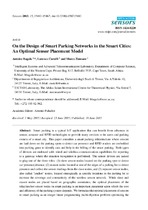| dc.contributor.author | Bagula, Antoine | |
| dc.contributor.author | Castelli, Lorenzo | |
| dc.date.accessioned | 2017-01-25T13:41:22Z | |
| dc.date.available | 2017-01-25T13:41:22Z | |
| dc.date.issued | 2015 | |
| dc.identifier.citation | Bagula, A. et al. (2015). On the design of smart parking networks in the smart cities: an optimal sensor placement model. Sensors,15: 15443-15467 | en_US |
| dc.identifier.issn | 1424-8220 | |
| dc.identifier.uri | http://hdl.handle.net/10566/2494 | |
| dc.identifier.uri | http://dx.doi.org/10.3390/s150715443 | |
| dc.description.abstract | Smart parking is a typical IoT application that can benefit from advances in
sensor, actuator and RFID technologies to provide many services to its users and parking
owners of a smart city. This paper considers a smart parking infrastructure where sensors
are laid down on the parking spots to detect car presence and RFID readers are embedded
into parking gates to identify cars and help in the billing of the smart parking. Both types
of devices are endowed with wired and wireless communication capabilities for reporting
to a gateway where the situation recognition is performed. The sensor devices are tasked
to play one of the three roles: (1) slave sensor nodes located on the parking spot to detect
car presence/absence; (2) master nodes located at one of the edges of a parking lot to detect
presence and collect the sensor readings from the slave nodes; and (3) repeater sensor nodes,
also called ''anchor'' nodes, located strategically at specific locations in the parking lot to
increase the coverage and connectivity of the wireless sensor network. While slave and
master nodes are placed based on geographic constraints, the optimal placement of the
relay/anchor sensor nodes in smart parking is an important parameter upon which the cost
and e ciency of the parking system depends. We formulate the optimal placement of sensors
in smart parking as an integer linear programming multi-objective problem optimizing the
sensor network engineering e ciency in terms of coverage and lifetime maximization, as
well as its economic gain in terms of the number of sensors deployed for a specific coverage
and lifetime. We propose an exact solution to the node placement problem using single-step
and two-step solutions implemented in the Mosel language based on the Xpress-MPsuite of
libraries. Experimental results reveal the relative e ciency of the single-step compared to
the two-step model on di erent performance parameters. These results are consolidated by
simulation results, which reveal that our solution outperforms a random placement in terms
of both energy consumption, delay and throughput achieved by a smart parking network. | en_US |
| dc.language.iso | en | en_US |
| dc.publisher | MDPI | en_US |
| dc.rights | All articles published by MDPI are made immediately available worldwide under an open access license | |
| dc.subject | Internet-of-things | en_US |
| dc.subject | Wireless sensor networks | en_US |
| dc.subject | Smart parking | en_US |
| dc.subject | Radio frequency identification | en_US |
| dc.subject | Optimal sensor placement | en_US |
| dc.title | On the design of smart parking networks in the smart cities: an optimal sensor placement model | en_US |
| dc.type | Article | en_US |

